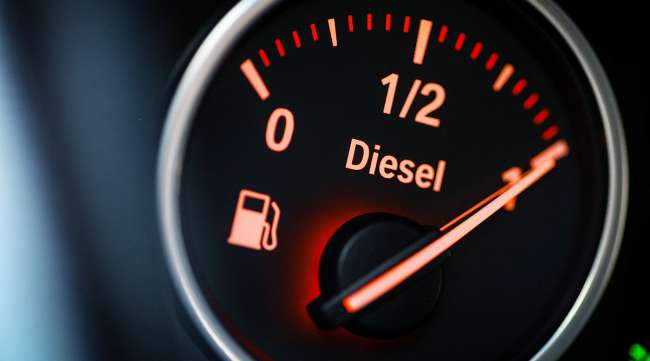Senior Reporter
Diesel Drops 1.1¢ to $3.16 a Gallon; Oil Slides to $61 a Barrel

The U.S. average retail price of diesel fell 1.1 cents to $3.160 a gallon, the Department of Energy reported May 13. Oil prices slipped to $61 a barrel as the United States and China imposed higher tariffs on the other’s goods, which chilled the outlook for crude.
Diesel costs 7.9 cents less than it did a year ago, DOE said.
U.S. average #diesel fuel price on 5/13/2019 was $3.160/gal, DOWN 1.1¢/gallon from 5/06/19, DOWN 7.9¢/gallon from hear ago https://t.co/KdVOfCbdHS #truckers #shippers #fuelprices pic.twitter.com/NRfhNRmEZE — EIA (@EIAgov) May 14, 2019
Regional diesel prices were mixed, lower in seven regions and higher in three. The top price was in California, where diesel climbed 3.9 cents to $4.136 a gallon. The lowest price was in the Gulf Coast region where it dropped 2.2 cents to $2.905.
Also last week, the national average price for regular gasoline fell 3.1 cents to $2.866 a gallon, DOE’s Energy Information Administration said.
The national average is 0.7 cent lower than a year ago, EIA said.
Regional average gasoline prices also were mixed, falling in seven areas and climbing in two.
One family-owned truckload carrier pays close attention to managing diesel expenses.
“We have a really great fuel manager, Ronda Hancock, who oversees that process and makes sure the drivers are getting to the fuel stops they need to,” Jarit Cornelius, vice president of asset maintenance and compliance for Sharp Transport Inc., told Transport Topics. “She does a really good job in watching our prices each day as far as what our discounted rates are and making sure we take advantage of that.”
Ethridge, Tenn.-based Sharp operates 135 Class 8 trucks, and the company used 440,000 gallons of diesel in the first quarter.
Getting drivers to comply with the fuel purchase plan is not difficult to accomplish, Cornelius said.
“But there are occasions where you have to have some of that one-one conversation with a few drivers,” he said. “It could be about out-of-route miles, or a customer that held them up for awhile and they got off track. There’s a lot of things that usually come into play.”
Alternative fuels always cross his mind.
“But it’s not as economical with what we are doing right now,” Cornelius said. “We try to be as fuel conscious and as efficient as we can. We constantly coach our drivers on their driving habits — idle times and shift patterns. But as far as alternative fuels, I don’t think that is something on Sharp Transports’ immediate agenda right now.”
Meanwhile, in its latest Alternative Fuels Quarterly, ACT Research reported that despite a soft January, sales of natural gas-powered vehicles picked up in February, month-over-month (up 44%) and year-over-year (up 13%).
ACT: Class 8 Natural Gas Truck Sales Down 12% YTD. Coverage of our AFQ report from MonitorDaily #alternativefuels #ev #cev #naturalgas #commercialvehicles https://t.co/TcnyYs9UYR pic.twitter.com/bNGcrdg5x6 — ACT Research (@actresearch) May 3, 2019
“Based on news released in the popular press, natural gas vehicle purchases continued to be dominated by refuse fleets, as well as transit and school bus operators,” ACT General Manger Kenny Vieth wrote in the report. “Among truckers, it appears as though the majority of incremental volume came from current natural gas vehicle users replacing units or increasing their number.”
West Texas Intermediate crude futures on the New York Mercantile Exchange closed at $61.04 per barrel May 13, compared with $62.25 on May 6.
China announced higher tariffs on a range of American goods May 13 in response to new levies promised by the Trump administration after talks ended May 10 without a deal.
Beijing announced a new 25% tariff on almost 2,500 American products, including liquefied natural gas shipments. Markets recovered some of their ground after President Donald Trump indicated he will speak with Chinese counterpart Xi Jinping at the end of June during the G-20 summit. Trump said he hasn’t decided whether to follow through on a threat of further penalties against $300 billion in Chinese imports, Bloomberg News reported.
China did not put crude oil on its tariffs list, but the flow of American cargoes to China already has been throttled. China imported 1.64 million barrels of American oil in the six months through March, down from 60.5 million barrels in the prior six months. Four of the most recent months saw no shipments, according to Bloomberg.

An Emirati coast guard vessel passes an oil tanker off the coast of Fujairah, United Arab Emirates, on May 13. Saudi Arabia said two of its oil tankers were sabotaged off the coast of the United Arab Emirates near Fujairah in attacks that caused "significant damage" to the vessels. (Jon Gambrell/AP)
Worries about demand overrode fears that tensions in the Middle East could be coming to a boil after the Saudis said two of their tankers were damaged in what was called a sabotage attack. The United Arab Emirates said a UAE vessel and a Norwegian ship also were targeted off the Emirati port of Fujairah.
Details remained sparse, however, with neither the Saudis nor the UAE saying what happened or identifying potential culprits. The United States deployed an aircraft carrier, bomber planes and defense missiles to the region last week amid worsening friction with Iran, Saudi Arabia’s regional rival.
“It’s all about uncertainty; whether it’s a founded or unfounded rumor, the market does not like it,” Scott Bauer, CEO at Prosper Trading Academy in Chicago, told Bloomberg.




